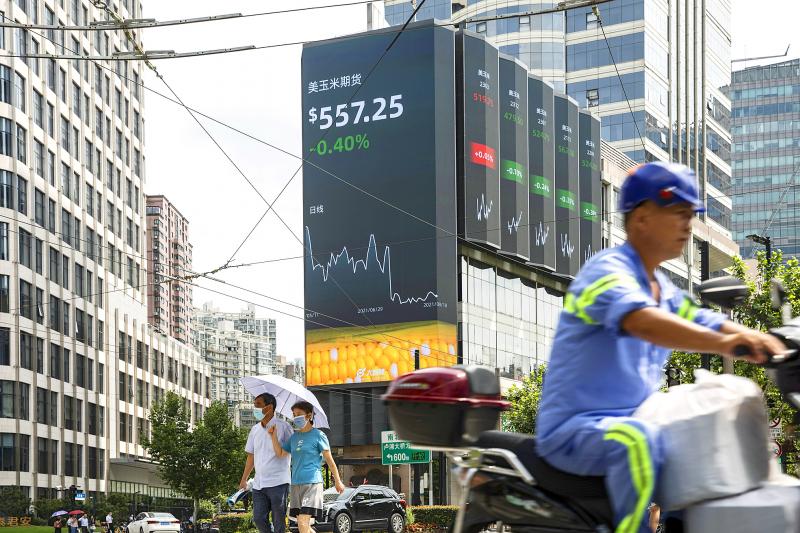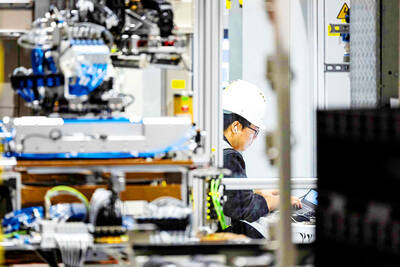China’s tough virus curbs mean that economic activity in the third quarter could be close to flat compared with the previous three months, while full-year growth may fall below 8 percent, a top forecaster said.
“My view is that the Chinese economy should slow sharply in the third quarter, mainly due to the virus but also controls on property,” Market Securities LLP chief economist Christophe Barraud said.
Barraud was Bloomberg’s top-ranked forecaster for the Chinese economy last year.

Photo: Bloomberg
Barraud’s prediction of 0.3 percent growth in the period between July and September from the previous three months is below the median estimate of 1.1 percent in a Bloomberg survey of economists.
Barraud is also bearish on China’s growth for this year compared to the market’s median estimate of 8.4 percent.
“It should be close to 8 percent, but with risks tilted to the downside,” he said. “If there is another outbreak in the fourth quarter, forecasts should be adjusted below 8 percent.” The government has set a target of above 6 percent growth for the year.
Barraud’s prediction came after monthly data showed China’s economy slowing sharply last month, with a slump in retail sales and property construction.
China introduced tougher curbs on travel to squash an imported outbreak of the Delta variant of SARS-CoV-2 from late July. While the measures quickly brought the virus under control, a new cluster has developed in southern China this month, suggesting some restrictions will remain and consumers will continue to be cautious.
“Risks are tilted to the downside because China will keep implementing a zero-tolerance policy concerning COVID-19, particularly ahead of the Winter Olympics in February,” Barraud said.
The France-based economist said that one of his favorite indicators of Chinese economic activity at the moment is the daily number of domestic flights.
“It’s the most reliable data to catch the impact of restrictive measures,” he said.
China is scheduled to release third-quarter gross domestic product data on Oct. 18. In the second quarter, GDP rose 7.9 percent from the same period last year, and 1.3 percent from the previous quarter.
Barraud said his forecasting technique involves trying to collect as much data as possible, including from private providers, before constructing a simple model with just five inputs for each predicted economic variable.
Those forecasts are adjusted based on experience and comparison with competitors, he said.
For the remainder of the year, infrastructure investment and fiscal spending are to be key variables indicating the extent to which Beijing is trying to support growth, he said.
The focus could be more on public investment “because everyone is waiting for public support,” he said.

CHIP RACE: Three years of overbroad export controls drove foreign competitors to pursue their own AI chips, and ‘cost US taxpayers billions of dollars,’ Nvidia said China has figured out the US strategy for allowing it to buy Nvidia Corp’s H200s and is rejecting the artificial intelligence (AI) chip in favor of domestically developed semiconductors, White House AI adviser David Sacks said, citing news reports. US President Donald Trump on Monday said that he would allow shipments of Nvidia’s H200 chips to China, part of an administration effort backed by Sacks to challenge Chinese tech champions such as Huawei Technologies Co (華為) by bringing US competition to their home market. On Friday, Sacks signaled that he was uncertain about whether that approach would work. “They’re rejecting our chips,” Sacks

NATIONAL SECURITY: Intel’s testing of ACM tools despite US government control ‘highlights egregious gaps in US technology protection policies,’ a former official said Chipmaker Intel Corp has tested chipmaking tools this year from a toolmaker with deep roots in China and two overseas units that were targeted by US sanctions, according to two sources with direct knowledge of the matter. Intel, which fended off calls for its CEO’s resignation from US President Donald Trump in August over his alleged ties to China, got the tools from ACM Research Inc, a Fremont, California-based producer of chipmaking equipment. Two of ACM’s units, based in Shanghai and South Korea, were among a number of firms barred last year from receiving US technology over claims they have

It is challenging to build infrastructure in much of Europe. Constrained budgets and polarized politics tend to undermine long-term projects, forcing officials to react to emergencies rather than plan for the future. Not in Austria. Today, the country is to officially open its Koralmbahn tunnel, the 5.9 billion euro (US$6.9 billion) centerpiece of a groundbreaking new railway that will eventually run from Poland’s Baltic coast to the Adriatic Sea, transforming travel within Austria and positioning the Alpine nation at the forefront of logistics in Europe. “It is Austria’s biggest socio-economic experiment in over a century,” said Eric Kirschner, an economist at Graz-based Joanneum

France is developing domestic production of electric vehicle (EV) batteries with an eye on industrial independence, but Asian experts are proving key in launching operations. In the Verkor factory outside the northern city of Dunkirk, which was inaugurated on Thursday, foreign specialists, notably from South Korea and Malaysia, are training the local staff. Verkor is the third battery gigafactory to open in northern France in a region that has become known as “Battery Valley.” At the Automotive Energy Supply Corp (AESC) factory near the city of Douai, where production has been under way for several months, Chinese engineers and technicians supervise French recruits. “They